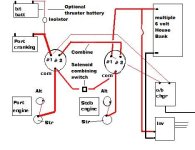I may not be the right person to offer you help on this due my preferences with regard to
Redundancy and
KIS (keep it simple).
IMOO, we want "Cranking" batteries for our engine starting needs.... NOT dual purpose batteries or
single Deep Cycle batteries.
And again IMOO, both engines should not be capable of providing HLBB power (HLBB = house load battery bank).
There is no redundancy if we set things up this way.
We want to keep a dedicated cranking battery in "Reserve" (unless we were certain that a battery management mistake would not occur).
I am not familiar with your boat, but I'll bet that there are times when you may have considerable 12vdc House Loads.
Lights, phone chargers, TV, Inverters, radio, etc.
These loads are generally best served if a large bank of Deep Cycles are installed and dedicated for this purpose ONLY.
Better yet..... 6 volt Golf Cart batteries in series (these offer increased Amp Hours over that of 12 volt batteries in parallel).
Note that on many OEM set-ups, the Stbd engine (if set up this way) will source the House Loads.
Meaning that the cabin lights, Stbd helm, Nav Lights, Anchor Lights, Heater/Wipers, etc, will be sourced from the Stbd Engine Harness/Hull Harness interface (unless this has been changed, or if the boat was not originally set up this way).
Ideally we will keep the HLBB separate from the SLBB for this same Stbd side engine.... and again, keeping the cranking battery in "Reserve" while on the hook or docked, etc.
This is commonly acheived via an MBSS ( i.e., main battery selector switch.... 1/ALL/2/OFF).
This may mean two battery banks for the Stbd side.
One "cranking" (typically on #1)...... and one large bank of multiple Deep Cycle batteries (typically on #2).
However, this can be altered as shown in the attached schematic.
(see attached image)
This is a very simple installation for twin engines.
This is not does not offer any automatic switching or charging, etc.
All of that can be added via an ACR or VSR at any time later on.
While I did mention that we want to use a dedicated "cranking" battery for our starting needs..... there is way to use a large bank of Deep Cycyle batteried for "cranking".
Note that the Stbd engine has only one battery bank..... a large bank of Deep Cycles!
The space that would normally be used for a cranking battery, can now be used for an incresed HLBB.
Note the manual and solenoid "combining feature" from the Port side cranking bank to the Stbd side.
For me, on my own boat, this is my Stbd side redundancy!
The solenoid feature is helm switch controlled.
(I use this system, and it works very well)
Again, this can also done with the use of an ACR unit.
I've been cranking my Stbd engine on my large HLBB for years now..... and ZERO issues to date.
The "key" to this, is quick firing engines, and a large bank that is capable of providing cold cranking amps.... of which we do not normally do with smaller banks of Deep Cycle batteries.
Increase the capacity, and we gain in two areas.....
House Load capacity and Cranking ability.
A system like this does require some degree of manual battery management.
For a seasoned captain or helmsman, this is usually not an issue.
Add one of Xantrex's LINK systems, and you can't go wrong.
Of course your generator will have it's own battery also.
Edit:
I'd also suggest that O/B Charger leads connect directly to the rear of our MBSS (#1 and #2 terminals), rather than make direct battery connections.
This is schematically identical, but eliminates small terminal corrosion that can occur at direct battery connections.
Also eliminates the typical Rat's Nest that we so often see at batteries.
A main bilge pump float switch can also make it's connection to the #2 terminal (typically the largest bank).
(if the attached schematic was used, this would become #1 terminal)
This remains "Un-Interruptible", but again with no direct battery corrosion potential.
All of the above circuits remain active regardless of MBSS selection, including OFF.
While leaving your boat unattended..... ya switch on your O/B Smart Charger.... ya turn the MBSS OFF, and all is good!
If you moore, your main bilge pump float switch is on Stand-By ready to go.
****************************
There's always more than one way to skin a cat... but the Furier may prefer one over the other.

Anyway.... just a few suggestions for you.


